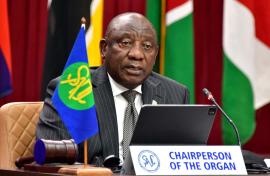
NAIROBI, Aug 8 (NNN-KBC) — Kenya has been validated by the World Health Organization (WHO) for eliminating Human African Trypanosomiasis (sleeping sickness) as a public health problem, marking a historic milestone in disease control.
Speaking Friday at the ceremony themed “One Health One Fight Towards a Sleeping Sickness-Free Kenya,” Health Cabinet Secretary Aden Duale noted that the country has reported zero indigenous cases since 2009 — a result of strong policy, leadership, scientific excellence, and community action.
The CS commended health workers, technical partners, and communities, and reaffirmed commitment to sustained surveillance, early detection, community engagement, and integration of HAT services into primary health care.
The achievement aligns with Kenya’s Emergency Preparedness and Response agenda, supported by investments in the National Public Health Institute (NPHI) to strengthen disease surveillance and rapid response.
This validation marks a major public health milestone for Kenya, as we celebrate the elimination of a deadly disease in our country. The achievement will not only protect our people but also pave the way for renewed economic growth and prosperity,” said CS Duale.
Kenya now becomes the 10th country to reach this important milestone.
The first cases of HAT in Kenya were detected in the early 20 century. Since then, Kenya has engaged in consistent control activities, without indigenous new cases reported for over 10 years. The last autochthonous case was detected in 2009, and the last two exported cases, infected in the Masai Mara National Reserve, were detected in 2012.
Recently, Kenya strengthened HAT surveillance in 12 health facilities in six historically endemic counties to act as sentinel sites. They were equipped with diagnostic tools and had their clinical personnel trained on diagnostic procedures, including the most sensitive and practical tests for r-HAT.
The country also actively monitors the control and surveillance of tsetse flies and animal trypanosomiasis, both within and beyond the historical HAT endemic areas, supported by the national veterinary health authorities and the Kenya Tsetse and Trypanosomiasis Eradication Council (KENTTEC).
“This key milestone reflects Kenya’s efforts and commitment over many years, as a collaboration between national and county governments, national research institutions, development partners and affected communities,” said Dr Patrick Amoth, Director General of Health.
“The country remains fully committed to sustain the quality of care and surveillance in line with WHO’s recommendations”, he affirmed.
Supported by WHO and partners, including FIND, Kenya’s HAT elimination programme will now implement a post-validation surveillance plan to detect any potential resurgence or reintroduction of transmission.
HAT is the second neglected tropical disease (NTD) to be eliminated in Kenya: the country was certified free of Guinea worm disease in 2018.
“I congratulate the government and people of Kenya on this landmark achievement,” said Dr Tedros Adhanom Ghebreyesus, WHO Director-General. “Kenya joins the growing ranks of countries freeing their populations of human African trypanosomiasis. This is another step towards making Africa free of neglected tropical diseases”.
HAT a vector-borne disease caused by the blood parasite Trypanosoma brucei. It is transmitted to humans through the bites of tsetse flies that have acquired the parasites from infected humans or animals. Rural populations dependent on agriculture, fishing, animal husbandry or hunting are most at risk of exposure.
It is transmitted only on the African continent. The disease exists in two forms, gambiense and rhodesiense. The rhodesiense form, which is found in eastern and southern Africa, is the only one present in Kenya. It is caused by Trypanosoma brucei rhodesiense (r-HAT) and progresses rapidly, invading multiple organ,s including the brain. Without treatment, it is fatal within weeks.
WHO pledged to continue supporting ongoing monitoring in previously affected areas and maintains a stock of medicines to ensure rapid treatment of possible future cases..
“This success was made possible by the Ministry of Health’s leadership, the dedication of health workers in areas at risk and the support from key partners. WHO is proud to have contributed to this achievement and encourages all stakeholders to remain involved in post-validation monitoring, ” said Dr Abdourahmane Diallo, WHO Representative to Kenya.
A total of 57 countries have eliminated at least one NTD. Of these, 10 (including Kenya) have successfully eliminated HAT as a public health problem. The other countries that have reached this milestone are Benin, Chad, Côte d’Ivoire, Equatorial Guinea, Ghana, Guinea, Rwanda, Togo and Uganda. — NNN-KBC




